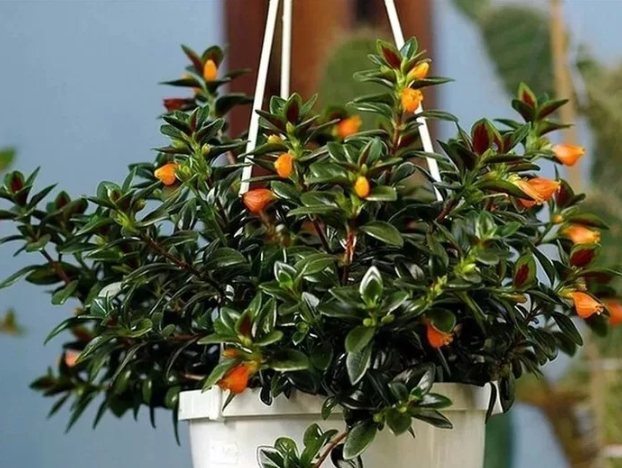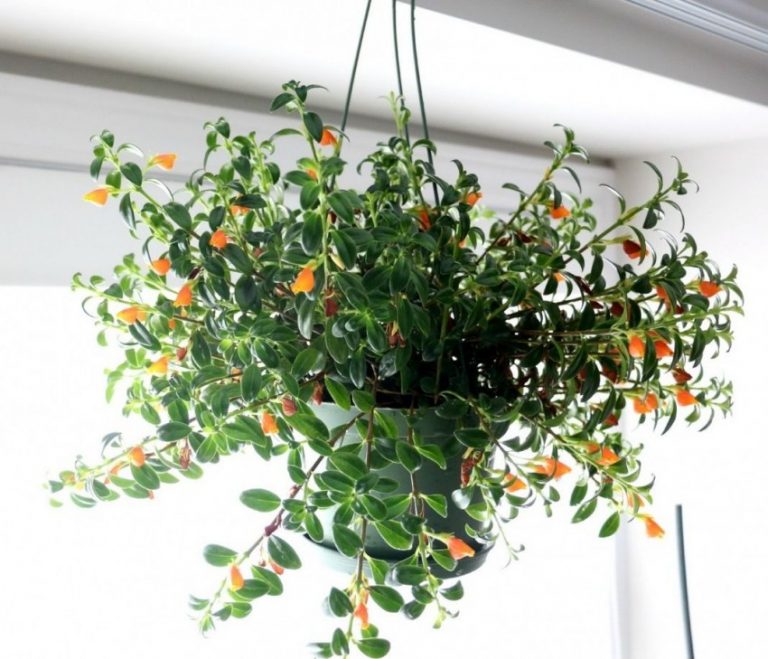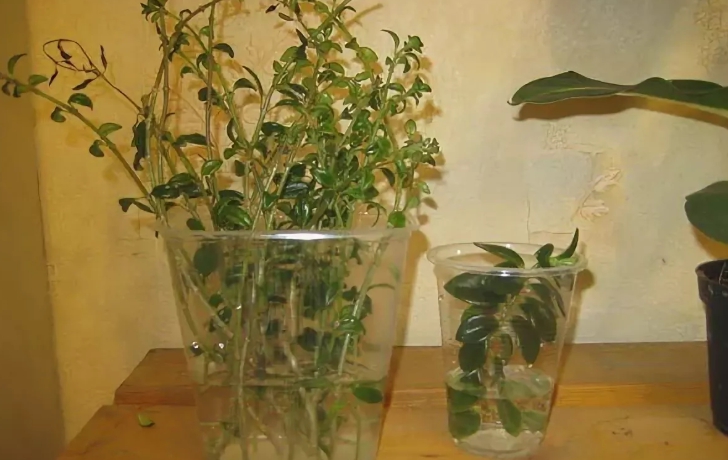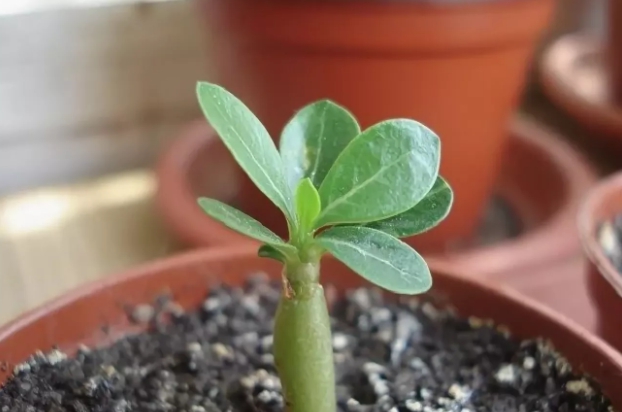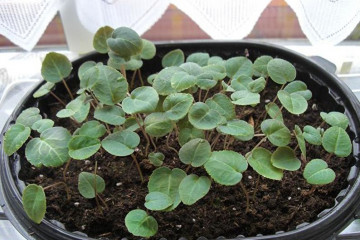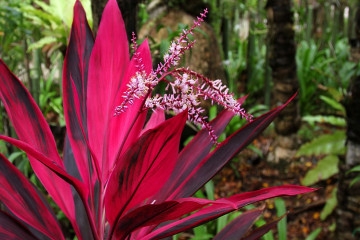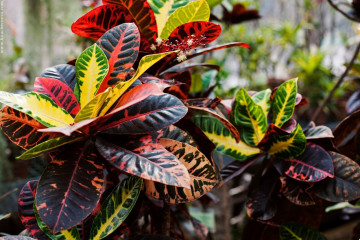Hypocyrta glabra: breeding methods and home care
Content:
The hypocyrt plant has a second name - nemantus, under which it can be found in modern literature. Previously, these were two independent genera, and now they are combined into one - Nematanthus. That is why hypocyrta glabra (naked) is the same as nemantus glabra.
The plant forms a bush with erect branches up to 60 cm long each. The leaves are evergreen, lighter on the inside. In summer, 2-3 bright orange buds of an unusual shape grow from the leaf sinuses at the ends of the branches.
Hypocyrta - home care
It is not difficult to create a suitable environment for active growth and flowering of hypocyrtes in an apartment. The plant is most demanding of air humidity, since it comes from the humid forests of the Amazon. It will be able to live in not very bright light, in not the most nutritious soil and will not die if you forget to water it in time. But in dry air the hypocyrt will gradually wither away.
Illumination
The plant pot should be positioned so that abundant but not direct light falls on it. In a room with windows to the south, the plant is placed at some distance from the windowsill, for example, on a table or in a floor stand for indoor flowers. Too bright sun leaves burns on the leaves. If there is too little light, buds will not appear, so northern windowsills should be avoided. The ones located in the southwest and southeast parts of the house are best suited.
You can use a hanging planter for planting by placing it in the upper part of the window facing east or west. In winter, it is advisable to provide the flower with artificial lighting with LED lamps for at least 4 hours a day (preferably early in the morning or after 15.00) in order to avoid ugly deformation of the crown and stretching of the shoots.
It is not recommended to put a pot with a plant in a room with an air conditioner or fan working in it, as this will lead to leaf fall.
Watering
When doing regular watering, it is important to maintain a balance: the soil should be as well moistened as possible, but not too much. At the roots, water should never stagnate, especially in the cold season. In the winter months, they do not stop watering the flower, but they do it very sparingly, sometimes it is enough to moisten only the top layer of the soil from a spray bottle.
When the bush blooms in the summer months, the frequency of watering is slightly increased. To do this, use only settled water at room temperature (from the tap is not suitable!). Excess moisture from the pallet is immediately drained so as not to provoke putrefactive processes in the roots. In the fall, watering is gradually reduced, focusing on the rate of drying out of the soil in the pot.
Humidity
In the conditions of its natural habitat, hypocyrt grows at a consistently high air humidity (up to 80% and even higher). It is difficult to achieve such indicators in a city apartment, but a level of 55-60% is enough. The pot, together with the pallet, is placed in a second, larger diameter container filled with wet pebbles. In the hot season, especially during flowering, the bush is sprayed from a fine spray with water early in the morning or late in the evening, but not every day.
Temperature
Hypocyrta tolerates smooth temperature fluctuations quite easily, but it can hurt due to sudden changes in "heat-cold". In summer, the optimal temperature regime for it is + 20 ... + 25 ° С. In winter, a slight decrease in temperature to + 14 ... + 16 ° C is allowed.
Top dressing and soil
Hypocyrt is fed at any age from mid-spring to mid-autumn every 10 days. To do this, use ready-made liquid or granular fertilizers for indoor decorative leafy plants. The concentration of the drug is chosen as the lowest recommended by the manufacturer in order to avoid burns of the root system.
Hypocyrte is suitable for moderately fertile, loose soil. It should allow moisture and air to pass freely to the roots. For self-preparation of the substrate, take leafy soil and mix it with a little river sand, peat and humus. A useful additive is crushed charcoal. From ready-made store-bought soils, substrates for violets are ideal (only black, not brown!).
Transplant features
Young plants in the first 2 years are transplanted every spring, in March. The new capacity is taken 25% more than the previous one. The root system grows more in breadth, so it is better to choose a pot wide, but not high. It is not recommended to increase the volume of the pot too radically. If the roots feel excessive freedom, this will lead to abundant growth of the green mass to the detriment of future flowering. You will get a lush bush with rare and small flowers.
Instances older than two years are transplanted less often, usually after 2 years or even 3. At the same time, the plant is carefully removed together with a clod of earth from the pot, trying not to damage the roots and disturb the clod. In a new pot, the thickness of the drainage layer is slightly increased, and fresh fertile soil is poured into it. The first day after transplanting, it is not necessary to irrigate the culture, and on the second day, watered as usual. The first feeding can be done only after 2 weeks.
Reproduction methods
Hypocyrta is a flowering plant, therefore it is easily propagated by seed. Its flowers are pollinated by insects, and in indoor conditions, if you wish, you can do it yourself using a toothpick.
An already available bush can be used for grafting. Healthy shoots without signs of wilting, disease and pest infestation are suitable for hypocyrte propagation. This is very convenient, because a heavily overgrown old bush can always be rejuvenated if it began to take up too much space on the window.
Cutting gives specimens 100% identical to the mother bush.
Cuttings
Every year after the completion of flowering, the hypocyrt needs a radical pruning of its crown. All its stems are shortened by half the length with a sharp pruner. The result is a neat, symmetrical crown. This is the only way to effectively stimulate the regrowth of new shoots and the laying of flower buds.
The fact is that buds can appear only on the shoots of the first year of life; flower buds do not form on older branches. But every year the increasing volume of the bush ceases to correspond to the size of the root system. Only in the open field will hypocyrt be able to bloom every year without pruning.In indoor conditions, without crown formation, you can not see flowers for the third year already.
It is not worth waiting for the end of flowering for cuttings. Shoots at this time are quite suitable for reproduction, but it is best to plant cuttings in the second half of spring. In this case, the rooted specimens will bloom next summer, having grown their own roots in sufficient quantity.
A cutting suitable for propagation has 3-4 internodes. It can be rooted in water or a mixture of peat and sand. The stalk is dipped into water or soil to the bottom pair of leaves, and covered with a transparent cap on top. Such a greenhouse should be placed in a warm place under diffused light. The roots should appear within a month, but if the branch has not given roots, then the cuttings are repeated this year or postponed for the next. Successfully rooted specimens are planted in a permanent pot and immediately pinched the crown for better tillering.
Seeds
If you are lucky to find hypocyrt seeds on sale, you can try to get seedlings. Seeds collected from their own bush should be sown immediately, as their germination capacity is lost within a year.
For sowing, peat and sand are mixed in equal proportions and cups with a capacity of 100 ml are prepared. They plant seeds in them, only lightly sprinkling them with sand on top. The substrate is watered and then covered with foil. Seedlings should be expected in 2-3 weeks. All this time, the seedling containers should be in a warm and bright place, where there are no drafts.
Finally, it is removed when the sprouts stretch 2-3 cm up. After that, after a month, you can plant them in individual pots and take care of them further, as for adults.
Even a beginner in indoor floriculture can provide care at home for a hypocirp glabra. The plant can be safely recommended to those who cannot devote a lot of time to the green inhabitants of the windowsills, but want to get a beautiful evergreen bush, abundantly and brightly blooming at home in summer.
